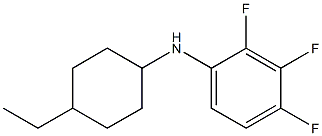2,4,6-Trifluoroaniline
- CAS NO.:363-81-5
- Empirical Formula: C6H4F3N
- Molecular Weight: 147.1
- MDL number: MFCD00007650
- EINECS: 206-660-8
- SAFETY DATA SHEET (SDS)
- Update Date: 2024-06-11 18:14:38

What is 2,4,6-Trifluoroaniline?
Chemical properties
COLORLESS TO LIGHT GREY CRYSTALS
The Uses of 2,4,6-Trifluoroaniline
2,4,6-Trifluoroaniline was used in the synthesis of 3-nitro-2,4,6 -trifluoroacetanilide; eries of N?-phenyl-N-(1- phenyl cyclopentyl)-methyl ureas and 4-substituted 2,6-difluoro N-aryl pyridinones.
The Uses of 2,4,6-Trifluoroaniline
2,4,6-Trifluoroaniline was used in the synthesis of:
- 3-nitro-2,4,6 -trifluoroacetanilide
- series of N′-phenyl-N-(1- phenyl cyclopentyl)-methyl ureas
- 4-substituted 2,6-difluoro N-aryl pyridinones
Properties of 2,4,6-Trifluoroaniline
| Melting point: | 33-37 °C (lit.) |
| Boiling point: | 57 °C/22 mmHg (lit.) |
| Density | 1.3510 (estimate) |
| Flash point: | 136 °F |
| storage temp. | Keep in dark place,Sealed in dry,Room Temperature |
| form | powder to lump to clear liquid |
| pka | 1.87±0.10(Predicted) |
| color | White or Colorless to Light yellow |
| Water Solubility | Insoluble in water. |
| BRN | 2831022 |
| CAS DataBase Reference | 363-81-5(CAS DataBase Reference) |
| NIST Chemistry Reference | 2,4,6-Trifluoroaniline(363-81-5) |
Safety information for 2,4,6-Trifluoroaniline
| Signal word | Danger |
| Pictogram(s) |
 Flame Flammables GHS02  Corrosion Corrosives GHS05  Exclamation Mark Irritant GHS07 |
| GHS Hazard Statements |
H228:Flammable solids H315:Skin corrosion/irritation H318:Serious eye damage/eye irritation H335:Specific target organ toxicity, single exposure;Respiratory tract irritation |
| Precautionary Statement Codes |
P210:Keep away from heat/sparks/open flames/hot surfaces. — No smoking. P240:Ground/bond container and receiving equipment. P280:Wear protective gloves/protective clothing/eye protection/face protection. P301+P312:IF SWALLOWED: call a POISON CENTER or doctor/physician IF you feel unwell. P305+P351+P338:IF IN EYES: Rinse cautiously with water for several minutes. Remove contact lenses, if present and easy to do. Continuerinsing. |
Computed Descriptors for 2,4,6-Trifluoroaniline
| InChIKey | BJSVKBGQDHUBHZ-UHFFFAOYSA-N |
New Products
Tert-butyl bis(2-chloroethyl)carbamate 4-Methylphenylacetic acid N-Boc-D-alaninol N-BOC-D/L-ALANINOL N-octanoyl benzotriazole 3-Morpholino-1-(4-nitrophenyl)-5,6-dihydropyridin- 2(1H)-one Furan-2,5-Dicarboxylic Acid DIETHYL AMINOMALONATE HYDROCHLORIDE 1,1’-CARBONYLDIIMIDAZOLE R-2-BENZYLOXY PROPIONIC ACID 1,1’-CARBONYLDI (1,2-4 TRIAZOLE) N-METHYL INDAZOLE-3-CARBOXYLIC ACID (2-Hydroxyphenyl)acetonitrile 4-Bromopyrazole 5-BROMO-2CYANO PYRIDINE 5,6-Dimethoxyindanone 5-broMo-2-chloro-N-cyclopentylpyriMidin-4-aMine 2-(Cyanocyclohexyl)acetic acid 4-methoxy-3,5-dinitropyridine 1-(4-(aminomethyl)benzyl)urea hydrochloride 2-aminopropyl benzoate hydrochloride diethyl 2-(2-((tertbutoxycarbonyl)amino) ethyl)malonate tert-butyl 4- (ureidomethyl)benzylcarbamate Ethyl-2-chloro((4-methoxyphenyl)hydrazono)acetateRelated products of tetrahydrofuran


![N-[(2-bromophenyl)methyl]-2,3,4-trifluoroaniline](https://img.chemicalbook.in/CAS/20200119/GIF/CB41830266.gif)




![N-[(2-bromo-4-fluorophenyl)methyl]-2,3,4-trifluoroaniline](https://img.chemicalbook.in/CAS/20200119/GIF/CB41830064.gif)
You may like
-
 2,4,6-Trifluoroaniline CAS 363-81-5View Details
2,4,6-Trifluoroaniline CAS 363-81-5View Details
363-81-5 -
 2,4,6-Trifluoroaniline CAS 363-81-5View Details
2,4,6-Trifluoroaniline CAS 363-81-5View Details
363-81-5 -
 1975-50-4 98%View Details
1975-50-4 98%View Details
1975-50-4 -
 2-HYDROXY BENZYL ALCOHOL 98%View Details
2-HYDROXY BENZYL ALCOHOL 98%View Details
90-01-7 -
 2-Chloro-1,3-Bis(Dimethylamino)Trimethinium Hexafluorophosphate 221615-75-4 98%View Details
2-Chloro-1,3-Bis(Dimethylamino)Trimethinium Hexafluorophosphate 221615-75-4 98%View Details
221615-75-4 -
 14714-50-2 (2-Hydroxyphenyl)acetonitrile 98+View Details
14714-50-2 (2-Hydroxyphenyl)acetonitrile 98+View Details
14714-50-2 -
 118753-70-1 98+View Details
118753-70-1 98+View Details
118753-70-1 -
 733039-20-8 5-broMo-2-chloro-N-cyclopentylpyriMidin-4-aMine 98+View Details
733039-20-8 5-broMo-2-chloro-N-cyclopentylpyriMidin-4-aMine 98+View Details
733039-20-8
Statement: All products displayed on this website are only used for non medical purposes such as industrial applications or scientific research, and cannot be used for clinical diagnosis or treatment of humans or animals. They are not medicinal or edible.